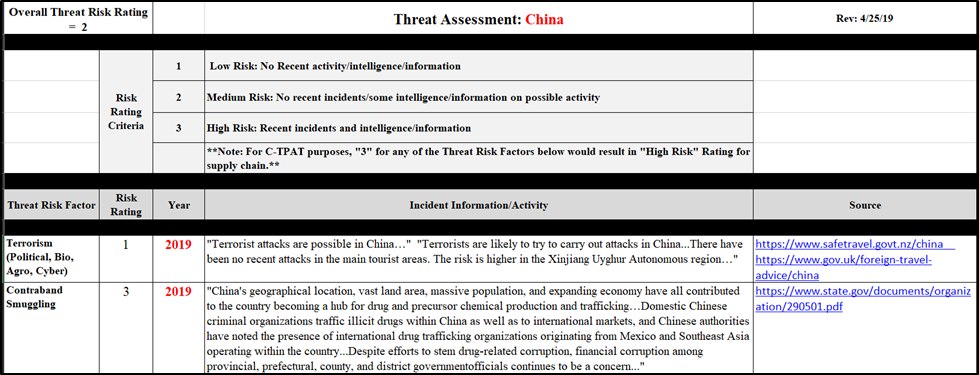Customs Trade Partnership Against Terrorism (CTPAT) is a Customs initiative that extends supply chain security to the point of origin to help facilitate secure trade and reduced U.S. Customs and Border Protection (CBP) security inspections for participants. To participate in CTPAT, a company must identify and close security gaps and meet minimum security criteria throughout their supply chain. Mohawk Global Trade Advisors can help you do just that.
Country Threat Assessment
Prior to sourcing your products, did you consider the risks associated with the country you would be purchasing from? If your answer is no, you are not alone. Most companies do not perform country threat assessments prior to sourcing.
As part of Mohawk Global Trade Advisors’ CTPAT package, we create and provide country threat assessments for each country our clients do business with. The assessment is a great tool to help make sound business decisions and circumvent potential issues when purchasing and importing goods.
Our country risk assessments follow the guidelines established by CBP. For each country, we review:
- Human rights compliance
- Terrorism
- Organized crime
- Contraband smuggling
- Conditions that may foster additional threats
- Theft, piracy, intellectual property rights infringement
Example Country Risk Assessment:

Cargo Flow Table
Knowing your supply chain is fundamental to creating a cargo flow chart. Surprisingly, many companies are unfamiliar with what happens to their cargo once it leaves the factory.
We work with our clients and their factories, freight forwarders and Customs brokers to determine who is handling the freight through each step of the supply chain. For example, clients are often surprised to learn their cargo is not always trucked directly from the factory to the port of export. Cargo may be trucked from the factory to an intermediary port, loaded onto a feeder vessel or barge, and then offloaded at the ultimate port of export.
We also work with clients to determine approximately how many days freight is at rest once leaving the factory. It’s important for clients to be aware of this figure because cargo at rest is cargo at risk for security breaches. By working with our clients to create cargo flow tables, we help them better understand the potential risks within their supply chain.
CTPAT Standard Operating Procedures (SOP) Template
CTPAT member companies are required to have written processes and procedures in place for the majority of the program’s required criteria. Our CTPAT SOP template provides the solid procedural framework our clients need in order to document their company’s CTPAT practices.
Our CTPAT SOP template is a comprehensive outline of all required CTPAT processes and procedures, including:
- Business partner screening procedures
- 7-, 8- and 17-point container/trailer inspection checklists
- Driver and visitor log templates
- Cybersecurity policy template
- And much more!
Our SOP format allows for flexibility in customizing content to your company’s size and business model.
Using this template, we create standard operating procedures for our clients that are guaranteed to meet the CTPAT program’s requirements.
Security Profile
Preparing a supply chain security profile can be daunting to say the least, but for MGTA, it’s second nature. Unlike many of our competitors, we don’t use canned templates to write your security profile. Each security profile varies depending on the business entity applying to CTPAT, and is the primary tool used by Customs when deciding whether or not to grant a company CTPAT certification status.
Using questionnaire and risk assessment responses from you and your business partners, MGTA takes the time to create a security profile that details your unique supply chain. This attention to detail allows us to thoroughly explain your supply chain security practices to your SCSS, and to showcase the ways in which you and your business partners are meeting the CTPAT program’s requirements. We can unequivocally state that every company we’ve worked with has been granted CTPAT certification due to the level of detail included in security profiles we create for our clients.
Importer Self-Assessment (ISA)
CTPAT-certified importers who join the ISA program are exempt from comprehensive Customs regulatory audits in exchange for monitoring their own compliance. MGTA can help you with the ISA application process by improving your compliance manual, documenting your best practices, developing your ISA self-testing plan and more. Contact us to learn more or to schedule an initial consultation.
CTPAT Training
MGTA also provides on-site training to ensure our clients thoroughly understand the CTPAT program. Employees will have the opportunity to speak to our experts directly, and receive introductory training on the program as well as security and threat awareness training − something that is required by the CTPAT program.
We also help our clients become familiar with the CTPAT Portal, a great resource to any CTPAT-certified company. The portal is not only home to the CTPAT security profile and important company information, but also contains a multitude of training materials clients can use to educate their employees and their partners overseas. These training materials cover topics such as container and seal inspections, internal conspiracies, preventing pest contamination and more. As the primary tool Customs uses to communicate with CTPAT-certified partners, it is important for our clients to understand how to navigate the portal and use it to their advantage.

